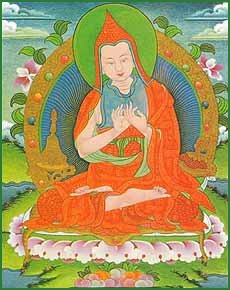The Great Chariot
by Longchenpa | 268,580 words
A Commentary on Great Perfection: The Nature of Mind, Easer of Weariness In Sanskrit the title is ‘Mahāsandhi-cittā-visranta-vṛtti-mahāratha-nāma’. In Tibetan ‘rDzogs pa chen po sems nyid ngal gso’i shing rta chen po shes bya ba ’...
Part 1b.3d - How to eliminate the bad
3.d.1) Bringing ourselves to the higher realms
Now, as for how to reverse those bad actions:
The ten good actions lead us to the higher realms.
Their good intention avoids the ten actions that are bad.
Cutting off life is avoided, and taking what is not given.
Wrongful sex is avoided, as well as lies and slander.
Speech is not harsh or frivolous. Thoughts are not covetous.
We keep ourselves far away from malice and wrong views.
However, merely by reversing these bad actions, the ten good ones will not occur. This is because our being has not been systematically restrained.
Therefore, the attitude that abandons the ten bad actions is ten good ones, the Middle Length Prajñaparamita says:
“I have abandoned the taking of life,” and so forth. These ten are said.
3.d.2) The explanation of the ripening of their fruition
As for the ripening of their fruition:
If these actions are small, we are born in the human realm.
Intermediate ones bring birth among gods in the realm of desire.
Great ones connect us to the samadhis of formless dhyana.Thus we can grasp the pleasures of the two higher realms.
The four results are the opposites of the previous ones.
The fruition should be known to be birth in the higher realms.
By lesser and intermediate good conduct, we are born among the human beings and gods of the desire realm. If it is great, since we are connected with samadhi, we are born in the two higher realms. Those higher realms are attained, and entrance into the lower realms is cut off. The Precious Garland says:
By these dharmas we are completely liberated
From being hell being, hungry ghost, or animal.
After birth among gods or humans, we attain in abundance
Happiness and glory, as well as royal dominion.
We experience bliss, such as the bliss of Bhrama,
In the measureless samadhis of the formless realms.
3.d.3) How we should choose what to accept and reject
As for how:
So it is that the ten that accord with goodness and merit
Lead to the higher realms, but the ten whose nature is
bad Lead instead to falling into the lower realms.Accept white cause and effect, and likewise reject the black.
This will be the path to worldly happiness,
The vehicle of god and humans taught by the Sage.By establishing subsequent lives in the higher realms,
We truly lay a foundation for our liberation.
Therefore, fortunate beings should depend on doing this.
The Middle Length Prajñaparamita says:
Subhuti, by accepting the true karmic path of these ten good actions, we are born in the celestial realms. By remaining on the path of the ten bad actions, we are born in the lower realms.
The White Lotus of Holy Dharma says:
The vehicle of gods and humans has the ten virtues.
The Supreme Essence (snying po mchog) says:
The vehicle of gods is the four dhyanas and the four formless attainments. The vehicle of humans is the ten virtues. The latter depends on good dharmas.
“Yana” means vehicle, mount, or means of conveyance. When we ride these vehicles, each one brings us to its particular fruition. The Prajñaparamitasañcayagatha says:
Traveling in it removes the sufferings of beings.
This vehicle is a great mansion, immeasurable as space.
This highest yana yields joy and happiness, and well-being.
Depending on different levels of mind, different vehicles are taught. For example, one is taught for those who aim at complete peace. The White Lotus says:
The single vehicles do not have the three vehicles.
They are taught as provisional skillful means.
Two are also taught. the Immaculate Space Sutra (nam mkha’ dri med pa’i mdo) says:
In accord with the affinities of sentient beings,
I have bestowed the teachings of two vehicles.
These two are the Mahayana and hinayana. Three are also taught. The White Lotus says:
Though gates of Dharma teaching how to tame the kleshas
Are said to be eighty-four thousand, the buddhas’ true intent
Is their one inseparable essence. That I have taught three vehicles
Is explained by the different powers and interests of beings.
In brief, the levels of mind that present themselves are limitless, and not all of them perceive the true meaning. The Sutra of the Descent into Lanka (Lankavatara Sutra, lang kar gshegs pa’i mdo) says:
For as long as minds are following it,
They do not reach the end of the vehicle;
But if a mind becomes one that has done this,
There are neither vehicle or travel.
In this case the vehicle of gods and humans is being discussed. The same text says:
The vehicle of gods and that of Bhrama,
And also that followed by the shravakas,
As well as the vehicle of pratyekabuddhas,
All these vehicles were taught by me.As for the vehicle of gods and humans,
Relying on it, pain is eliminated.
Afterwards it is not seen at all.
